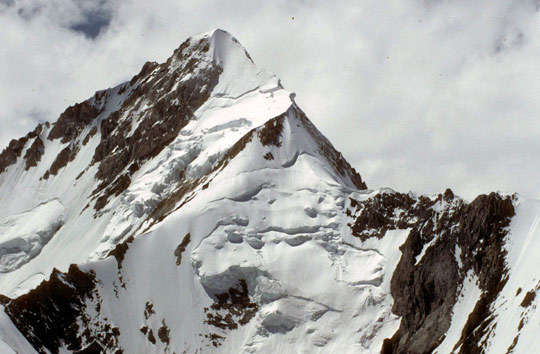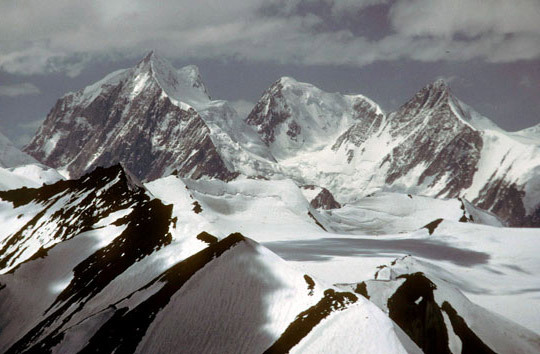
The summit pyramid of Chong Kumdan I (7071m) in India’s East Karakoram, as seen from the southeast. Until recently this was a highly restricted area: only Indian or foreign mountaineers forming joint expeditions with Indians were allowed to climb in this area, and even then permits were difficult to obtain. A recent government annoucement may have changed all this. The 2007 second ascent of Chong Kumdan I is believed to have followed the right skyline. [Photo] Lindsay Griffin
Edited October 22, 2010.
On September 13 the Government of India announced a full opening of the Siachen Glacier to climbers and trekkers. Even “tourists” will be able to travel as far as the traditional Army Base Camp. It is assumed that foreigners will no longer need to form joint expeditions with Indian nationals to climb in this region, and trekking will be allowed on the glacier. The previously war-torn Siachen has been an area long disputed by Pakistan and India: hopefully, there will be no adverse reaction from Pakistan to this news.
Indian nationals have been very active in the area this summer, climbing some major peaks, in at least one case by a new route.
A joint Indo-American expedition has made the second ascent of Chong Kumdam I (7071m) via a new route up the east-northeast ridge. In 1991 an Indo-British expedition, jointly led by Harish Kapadia and Dave Wilkinson, gained a permit to visit the Chong Kumdan Glacier in the East Karakoram, making the long trek from the Sasoma Army Camp below the Siachen, a journey that follows an historic trade route to China over the Saser La (5395m) and along the banks of the Shyok River. After warming up with a mass first ascent of Chong Kumdam V (6520m), south east of the main peak, Bill Church and Wilkinson inspected the east-northeast ridge of CKI from the Chogam I Glacier. During this foray they made the first ascent of CK4 (6520m) at the base of the ridge. While they were resting, most of the remaining climbers made an exploratory two-day trek, first west and then north to reach the head of the Chogam III Glacier immediately below the west side of CKI. From here two of the team, Lindsay Griffin and Paul Nunn, decided to try the subsidiary Kichik Kumdan (6640m) just west of the main summit. The successful ascent took considerably longer and proved rather more demanding than appearances had suggested, so the two were forced to rest while Church and Wilkinson, with Neil McAdie and John Porter, returned to climb a ramp on the west face of CKI, where they reached the upper northwest ridge and continued to the summit. From here they enjoyed splendid views northwest to the Rimo Group, west to the unclimbed Chong Kumdan II (7004m), the remaining virgin 7000m peak in this region, and south to the Mamostong Group. A subsequent attempt by Nunn and Griffin found changed conditions on this route and the pair retreated from 6640m. However, the expedition was successful in climbing several more peaks in the area, and inspecting the approach to CK II, with a conclusion that it looked straightforward but very lengthy.
The 2007 Indo-American team was the first to visit the Chong Kumdan Glacier for sixteen years. The main aim was the first ascent of Chong Kumdan II but they appear to have been stopped by the lengthy glacier approach from the south. It appears the condition of the glacier may have changed substantially since 1991. It is believed the eventual second ascent of Chong Kumdan I followed the route inspected by Church and Wilkinson. Unfortunately, it is also reported that the expedition was beset by tragedy: one porter died and an experienced Sherpa became very ill and was evacuated by helicopter.

Mamostong Kangri (7516m), south of the Chong Kumdan Massif in the Indian East Karakoram. Seen here the north face is over 2000-meters high and must be one of the greatest unclimbed snow and ice walls in the Indian Himalaya. However, finding a safe line is another matter. While camped nearly a mile from the bottom of this face in 1991, a British team was heavily buffeted by spindrift from a large serac avalanche, originating from high on the wall. The mountain was recently climbed again from the far side by an Indo-French team. [Photo] Lindsay Griffin
Mamostong Kangri (7516m)–which has an awesome ca. 2000-meter north wall that will become a super-route of the future, if a safe line can be discovered–was climbed again in 2007 by an Indo-French expedition. They repeated the original route via the southeast ridge to the upper northeast ridge, first climbed in 1984 by an Indo-Japanese expedition led by Balwant Sandhu (who made the first ascent of Changabang). This was a very strong team with experienced Japanese such as Ogata and Yamada, and Indians like Nandlal Purohit, Chauhan, PM Das and Rajiv Sharma. This high mountain now has received around half a dozen ascents by several different routes, but this apepars to be the first since 1992.
At the time of writing an expedition organized by the IMF is attempting Rimo I, a very difficult 7385-meter summit only climbed once previously; in 1988 by an Indo-Japanese expedition jointly led by Hukam Singh and Yoshi Ogata via the southwest ridge. Prior to the first ascent the mountain had defeated very capable climbers such as Victor Saunders and Stephen Venables (1985) and Peter Hillary (1986). Sadly, tragedy has already struck this expedition before it reached the mountain: one of the Indian team, an instructor from the Nehru Institute of Mountaineering, died while trying to cross the Terong River.
From Ladakh comes a report that the Indian Mountaineering Foundation (IMF) are in the process of setting up an office in Leh, allowing climbers to simply turn up and pay the required $100 for the popular “trekking peak” Stok Kangri. There were also rumours in Leh that the government may be opening many more peaks in the area for 2008.

The Rimo group from the Chong Kumdan Massif to the southeast. Rimo I (7385m) is the highest peak on the left and the only ascent to date was achieved in 1988 by an Indo-Japanese expedition via the ridge falling left from the summit. The peak is currently being attempted again by an Indian expedition. [Photo] Lindsay Griffin